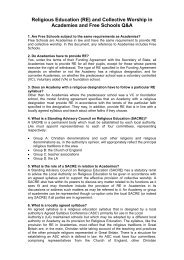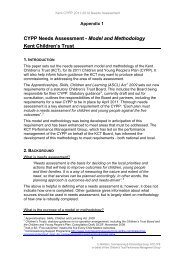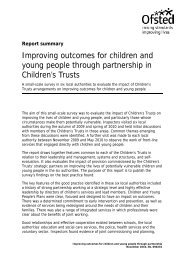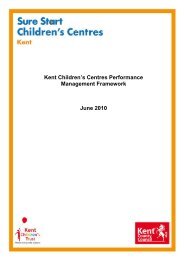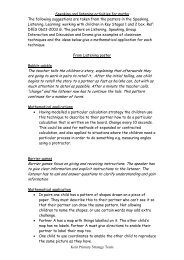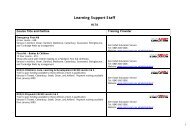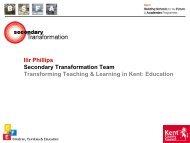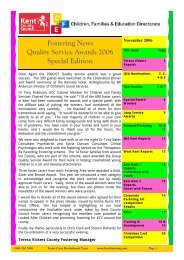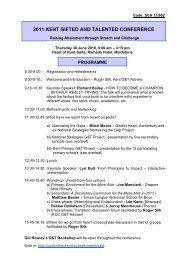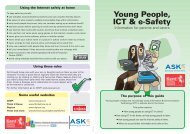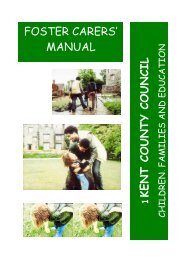Key Stage 1 - Kent Trust Web
Key Stage 1 - Kent Trust Web
Key Stage 1 - Kent Trust Web
You also want an ePaper? Increase the reach of your titles
YUMPU automatically turns print PDFs into web optimized ePapers that Google loves.
Writing assessment guidelines: levels 3 and 4<br />
Pupil name Class / Group Date<br />
AF5 - vary sentences for<br />
clarity, purpose and<br />
effect<br />
AF6 - write with<br />
technical accuracy of<br />
syntax and<br />
punctuation in<br />
phrases, clauses and<br />
sentences<br />
AF3 - organise and<br />
present whole texts<br />
effectively, sequencing<br />
and structuring<br />
information, ideas and<br />
events<br />
AF4 - construct<br />
paragraphs and use<br />
cohesion within and<br />
between paragraphs<br />
AF1 - write<br />
imaginative,<br />
interesting and<br />
thoughtful texts<br />
AF2 - produce texts<br />
which are<br />
appropriate to task,<br />
reader and purpose<br />
AF7 - select<br />
appropriate and<br />
effective<br />
vocabulary<br />
AF8 - use correct spelling<br />
Handwriting and<br />
presentation<br />
Level 4<br />
Across a range of<br />
writing<br />
• some variety in length,<br />
structure or subject of<br />
sentences<br />
• use of some<br />
subordinating<br />
connectives, eg if,<br />
when, because<br />
throughout the text<br />
• some variation,<br />
generally accurate, in<br />
tense and verb forms.<br />
Across a range of<br />
writing<br />
• sentences<br />
demarcated<br />
accurately throughout<br />
the text, including<br />
question<br />
• speech marks to<br />
denote speech<br />
generally accurate,<br />
with some other<br />
speech punctuation<br />
• comma used in lists<br />
and occasionally to<br />
mark clauses,<br />
although not always<br />
accurately<br />
Across a range of<br />
writing<br />
• ideas organised by<br />
clustering related<br />
points or by some time<br />
sequence<br />
• ideas are organised<br />
simply with a fitting<br />
opening and closing,<br />
sometimes linked<br />
• ideas or material<br />
generally in logical<br />
sequence but overall<br />
direction of writing not<br />
always clearly<br />
signalled<br />
Across a range of<br />
writing<br />
• paragraphs/sections<br />
help to organise<br />
contact, eg main idea<br />
usually supported or<br />
elaborated by<br />
following sentences<br />
• within paragraphs /<br />
sections limited<br />
range of connections<br />
between sentences,<br />
eg over-use of ‘also’<br />
or pronouns<br />
• some attempts to<br />
establish simple links<br />
between<br />
paragraphs/sections<br />
not always<br />
maintained, eg<br />
firstly, next<br />
Across a range of<br />
writing<br />
• relevant ideas and<br />
content chosen<br />
• some ideas and<br />
material developed in<br />
detail, eg<br />
descriptions<br />
elaborated by<br />
adverbial and<br />
expanded noun<br />
phrases<br />
• straightforward<br />
viewpoint generally<br />
established and<br />
maintained, eg writing<br />
in role or maintaining<br />
a consistent stance<br />
Across a range of<br />
writing<br />
• main purpose of<br />
writing is clear but<br />
not always<br />
consistently<br />
maintained<br />
• main features of<br />
selected form are<br />
clear and<br />
appropriate to<br />
purpose<br />
• style generally<br />
appropriate to task,<br />
though awareness of<br />
reader not always<br />
sustained<br />
Across a range of<br />
writing<br />
• some evidence of<br />
deliberate<br />
vocabulary<br />
choices<br />
• some expansion<br />
of general<br />
vocabulary to<br />
match topic<br />
Across a range of writing<br />
• correct spelling of<br />
o most common<br />
grammatical function<br />
words, including adverbs<br />
with –ly formation<br />
o regularly formed<br />
context/lexical words,<br />
including those with<br />
multiple morphemes<br />
o most past and present<br />
tense inflections, plurals<br />
• likely errors<br />
o homophones of some<br />
common grammatical<br />
function words<br />
o occasional phonetically<br />
plausible spelling in<br />
content/lexical words<br />
Level 3<br />
In most writing<br />
• reliance mainly on<br />
simply structured<br />
sentences, variation<br />
with support, eg some<br />
complex sentences<br />
• and, but, so are the<br />
most common<br />
connectives,<br />
subordination<br />
occasionally<br />
• some limited variation<br />
in use of tense and verb<br />
forms, not always<br />
secure<br />
In most writing<br />
• straightforward<br />
sentences usually<br />
demarcated<br />
accurately with full<br />
stops, capital letters,<br />
question and<br />
exclamation marks<br />
• some, limited, use of<br />
speech punctuation<br />
• comma splicing<br />
evident, particularly in<br />
narrative<br />
In most writing<br />
• some attempt to<br />
organise ideas with<br />
related points placed<br />
next to each other<br />
• openings and closings<br />
usually signalled<br />
• some attempt to<br />
sequence ideas or<br />
material logically<br />
In most writing<br />
• some internal<br />
structure within<br />
sections of text eg<br />
one-sentence<br />
paragraphs or ideas<br />
loosely organised<br />
• within paragraphs /<br />
sections, some links<br />
between sentences,<br />
eg use of pronouns<br />
or of adverbials<br />
• movement between<br />
paragraphs / sections<br />
sometimes abrupt or<br />
disjointed<br />
In most writing<br />
• some appropriate<br />
ideas and content<br />
included<br />
• some attempt to<br />
elaborate on basic<br />
information or events,<br />
eg nouns expanded<br />
by simple adjectives<br />
• attempt to adopt<br />
viewpoint, though<br />
often not maintained<br />
or inconsistent, eg<br />
attitude expressed,<br />
but with little<br />
elaboration<br />
In most writing<br />
• purpose established<br />
at a general level<br />
• main features of<br />
selected form<br />
sometimes signalled<br />
to the reader<br />
• some attempts at<br />
appropriate style,<br />
with attention to<br />
reader<br />
In most writing<br />
• simple, generally<br />
appropriate<br />
vocabulary used,<br />
limited in range<br />
• some words<br />
selected for effect<br />
or occasion<br />
In most writing<br />
• correct spelling of<br />
o some common<br />
grammatical function<br />
words<br />
o common content/lexical<br />
words with more than one<br />
morpheme, including<br />
compound words<br />
• likely errors<br />
o some inflected endings,<br />
eg past tense,<br />
comparatives, adverbs<br />
o some phonetically<br />
plausible attempts at<br />
content/lexical words<br />
In most writing<br />
• legible<br />
style,<br />
shows<br />
accurate<br />
and<br />
consistent<br />
letter<br />
formation,<br />
sometimes<br />
joined<br />
BL<br />
IE<br />
27<br />
Overall assessment (tick one box only) Low 3 Secure 3 High 3 Low 4 Secure 4 High 4



